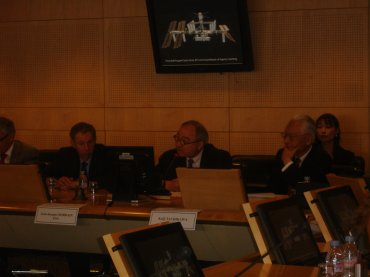Around lunchtime tomorrow, 50,000 fans at the Feyenoord stadium in Rotterdam, the Netherlands, will instigate two Mexican waves. But they won’t be cheering football players — it will all be in the name of physics.
The stunt is the idea of GertJan van Heijst, a physicist at Eindhoven University of Technology and fellow of the Royal Netherlands Academy of Arts and Sciences. To celebrate the 200th anniversary of the Academy, Van Heijst and his colleagues thought they would take the opportunity to stage an experiment at the Feyenoord grounds — which, coincidentally, is celebrating a 100-year anniversary.
It’s an open question whether Mexican waves are solitons GertJan van Heijst, Eindhoven University of Technology
Van Heijst told physicsworld.com that he is looking forward to doing the experiment in front of all the families who will be there for the jubilee. “We want to show the public how interesting science is,” he says.
The aim of the experiment is to explore whether Mexican waves behave in the same way as solitons, a type of wave that was first described mathematically by erstwhile Academy fellow Diederik Korteweg and his student in the late 19th century. Unusually for waves that travel in a physical medium, solitons travel at a constant speed without dispersing or changing shape. They are also unaffected when they collide with each other — and it is this property that van Heijst is looking for in human-borne Mexican waves.
“It’s an open question whether Mexican waves are solitons,” he explains.
‘Hard to predict’
Van Heijst plans to get the ball rolling on his experiment at around 1:15 pm (central European time) when he will ask fans in a small part of the terraces to momentarily stand up and throw their arms in the air. In time-honoured fashion, neighbouring fans on both sides will copy the movement so that two Mexican waves ripple clockwise and anticlockwise around the stadium.
When the waves meet at the opposite side of the stadium — which van Heijst expects will take no more than 20–seconds — cameras will monitor the interaction to see if the waves emerge unscathed.
If the Mexican waves deteriorate after their collision, van Heijst says he will repeat the experiment but this time ask the fans to look further afield and launch themselves upwards when they see a wave approach as close as, say, 10 people. This increases the “interaction length”, which — according to a mathematical model created by van Heijst and his team — must be a sufficient size for soliton characteristics to come about.
“The circumstances for such an experiment will be perfect,” says Jan van Merwijk, the Feyenoord stadium director, noting that the fans will be in high spirits. “We’ve seen a lot of waves circling through our venue but we have never experienced opposite waves. We’re very curious for the results and hope that the experiment will be a success.”
First observation
The first account of a soliton was published over 150 years ago by the UK engineer John Scott Russell. As the story goes, Scott Russell was watching a boat being drawn along a canal when the boat suddenly stopped and created a large wave some 30–m long.
We’re curious about the results and hope the experiment will be a success Jan van Merwijk, director, Feyenoord stadium
As he would later write, the wave was “a large solitary elevation, a rounded, smooth and well-defined heap of water, which continued along the channel apparently without change of form or diminution of speed.”
But will the observation of a solitary wave in a crowd of people reveal any new physics? The answer, perhaps surprisingly, is yes. Van Heijst is eager to find out if crowds of people can behave as a continuum — in other words, if they can demonstrate macroscopic properties based on microscopic behaviour. Physicists already know, for example, that granular media like sand behave as a continuum and act as fluids on large scales.
Although Van Heijst’s stunt has been mistakenly touted to have the most people ever involved in a scientific experiment — that award probably goes to the alien-searching “SETI@home” project, which currently has some three million participants worldwide — van Heijst thinks it will still be impressive.
“It’s good to show that science is fun,” he adds.
